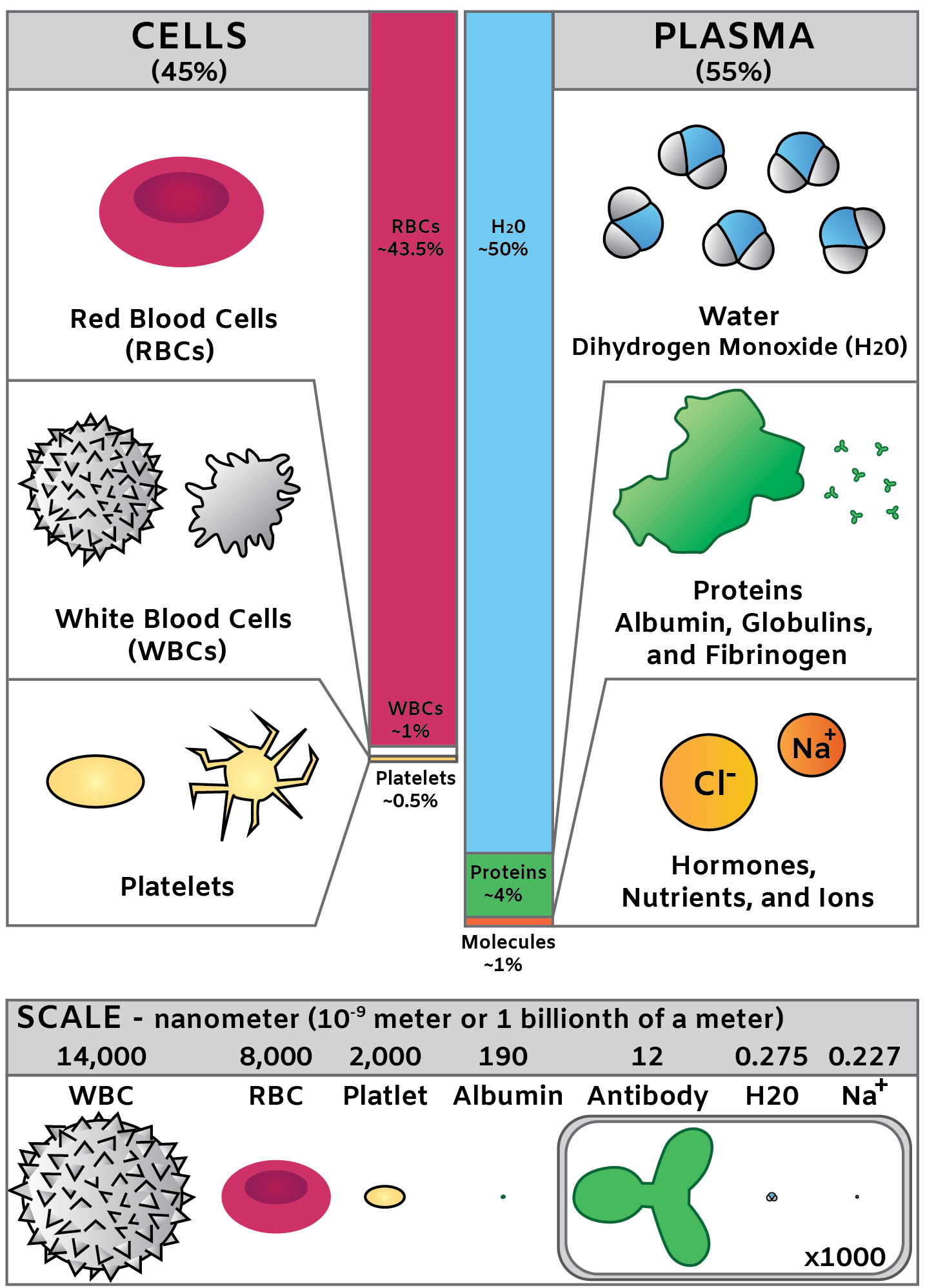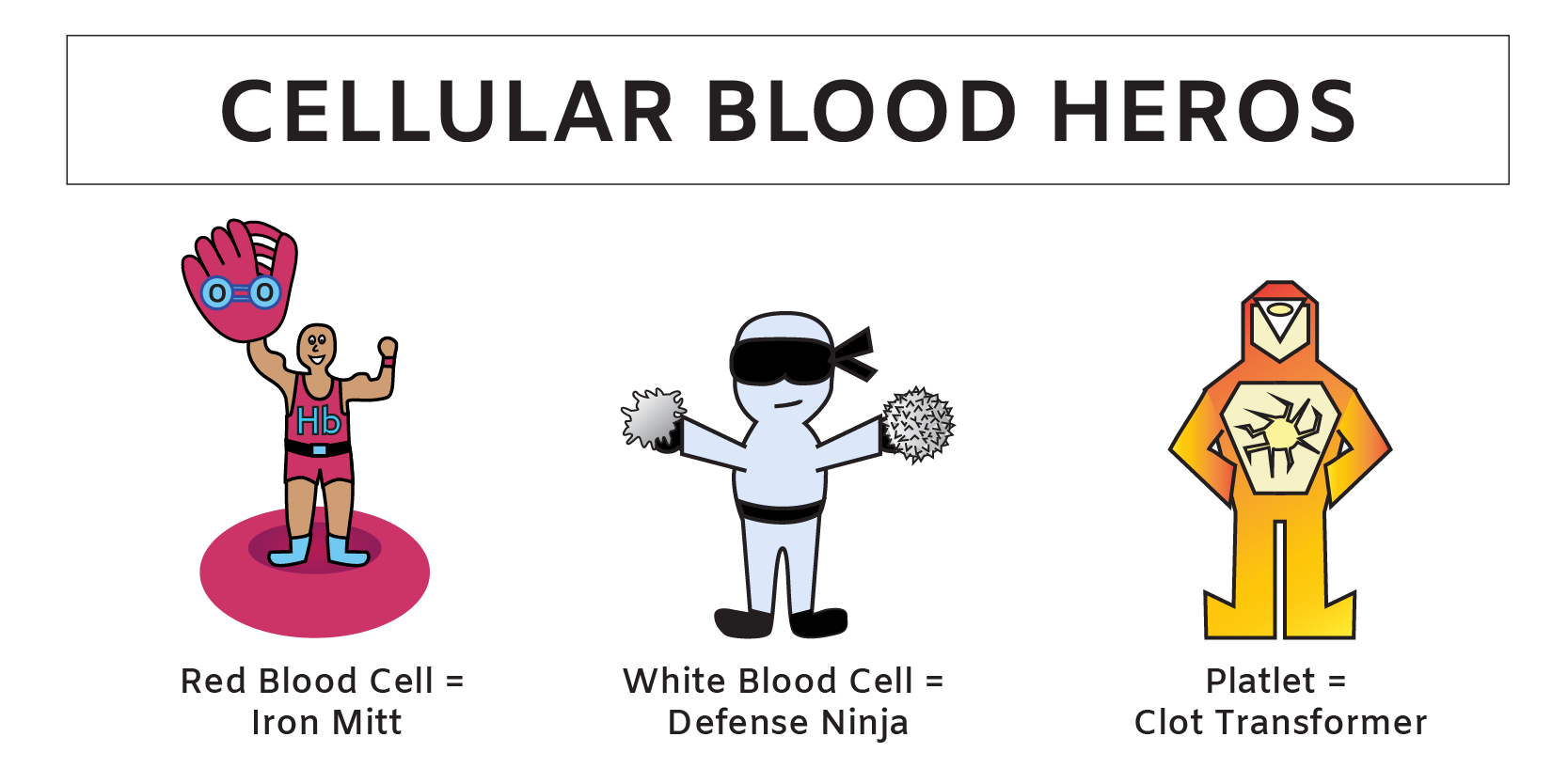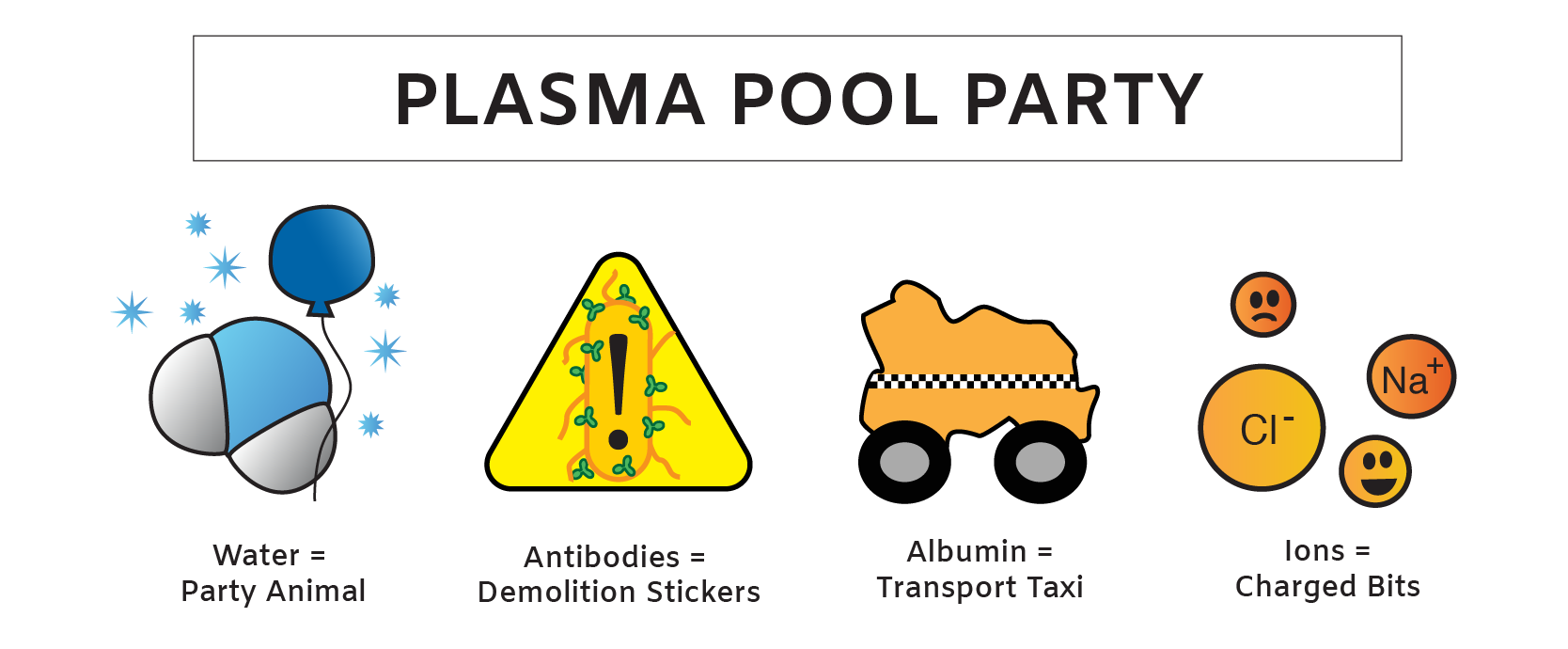What is Blood Made Of? Blood Composition and Functions
Learn More About Simplified Science PublishingBlood is a combination of plasma, red blood cells, white blood cells, and platelets.
Blood is an important part of your health and behavior. Blood cells and plasma affect your mood, your ability to fight infections, and your basic desires for food and sex. This is an educational science resource for anyone who wants to know more about what blood is made of and about the important blood functions that support your life.
Composition of blood and cell type percentages
Blood is made of 45% cells and 55% plasma. The cellular portion of blood is almost entirely made of red blood cells, but also contains a small amount of white blood cells and platelets. These three cellular components provide your body with oxygen transport, disease defense, and blood clotting.
Blood plasma is mostly made of water and contains many molecules that are dissolved in the liquid such as proteins, hormones, nutrients, and ions. These tiny pieces of your plasma determine many aspects of your emotions, behavior, and health. If you’ve never felt particularly grateful for the tiny bits flowing through your blood, you can put these at the top of your human anatomy appreciation list.

Red Blood Cells (RBCs)
Red blood cells (RBCs) make up nearly half of your blood volume (40-45%). They are shaped like round jelly donuts with an indent in the center that is stuffed with hemoglobin (Hb) proteins. The structure of a hemoglobin protein looks like four baseball mitts stitched together. Each mitt has an iron molecule in its center and these pockets create loose binding sites for dissolved gases such as oxygen and carbon dioxide. These heme-iron protein mitts are the reason why you are able to carry enough oxygen to live and they also give human blood its red color.
Every breath you take gives your body the oxygen you need to survive and allows for the removal of carbon dioxide, which is toxic at high concentrations. Blood is required to transport oxygen and carbon dioxide throughout your body and even though both of these gases can dissolve directly in the blood plasma, your cells require much more oxygen than can be carried in the plasma alone. This is why RBCs are necessary for your life—they provide efficient oxygen transport to support your body’s approximately 37.2 trillion cells.
In order to reach your cells from the blood, your heart pumps blood into the lungs where approximately one billion oxygen molecules can bind to the hemoglobin mitts in a single RBC. These oxygen-loaded RBCs then flow back into your heart where they are pumped out through the rest of your body’s blood tubes. Next, oxygen leaves RBCs near tissue where the oxygen level is low and enters the surrounding cells. Carbon dioxide can now bind to the emptied hemoglobin mitts and hitch a ride back to the lungs for release.
However, only 20-30% of the carbon dioxide that your cells produce is transported to the lungs via RBCs because most carbon dioxide is converted into bicarbonate instead. Bicarbonate does not bind to the hemoglobin and dissolves directly in blood plasma where it functions as an important acid-base buffer in your bloodstream.
Note: Red blood cells are not real cells because they do not have a nucleus or organelles. They are cell-like discs that are full of hemoglobin.

Anemia and Red Blood Cell Counts
If you experience excessive tiredness, weakness and difficulty breathing, a doctor may order blood tests to check your red blood cell levels as well as your oxygen, carbon dioxide, and bicarbonate levels. If your red blood cell count and oxygen levels are low, the doctor may conclude that you have anemia. Anemia is a condition in which you don’t have enough healthy RBCs to transport oxygen to your tissues and it is caused by blood loss, iron deficiency, vitamin deficiency, or impaired red blood cell production. Anemia also affects a whopping quarter of the global population. Make sure to support your RBCs with a well-balanced diet.
White Blood Cells (RBCs)
White blood cells are a tiny portion of your total blood volume (~0.5-1%) however, they are a crucial part of your body’s defense system. They are the immune system’s cellular defense ninjas that recognize and destroy invaders such as harmful fungi, bacteria, parasites, and also virus or disease infected cells. There are six main types of white blood cells and each type specializes in different areas of defense—some prefer to attack bacteria and others are highly skilled parasite assassins. When blood test results show an elevated white blood cell count, it often indicates that the body has an infection and is increasing the number of ninjas in the blood to fight. For a brief summary of the different white blood cell types, visit this UMRC resource.
Platelets
White blood cells are a tiny portion of your total blood volume (~0.5-1%) however, they are a crucial part of your body’s defense system. They are the immune system’s cellular defense ninjas that recognize and destroy invaders such as harmful fungi, bacteria, parasites, and also virus or disease infected cells. There are six main types of white blood cells and each type specializes in different areas of defense—some prefer to attack bacteria and others are highly skilled parasite assassins. When blood test results show an elevated white blood cell count, it often indicates that the body has an infection and is increasing the number of ninjas in the blood to fight. For a brief summary of the different white blood cell types, visit this UMRC resource.
What is blood plasma?
Plasma is Mostly Made of Water
Blood plasma makes up 55% of blood and it is the largest amount of liquid in your body. Blood plasma is approximately 92% water and the remaining 8% contains a powerful mix of molecules that control many basic behaviors and emotions. When you feel hungry, anxious, sleepy, or sick, the microscopic bits that dissolve in your blood plasma are primarily responsible for these feelings. This is because blood plasma contains hormones, antibodies and clotting proteins, as well as nutrients such as fats, vitamins, electrolytes, and other digested food particles. Each of these components could have a full article dedicated to their function and importance, but the focus of this article is on the organs that interact with blood, so the information provided is brief.

Plasma is 7% Protein
Around 7% of the stuff that is dissolved in the watery plasma are proteins that can be divided into three categories: albumin, globulins and fibrinogen. These proteins may not seem worth remembering due to their clunky names, but there are plenty of reasons to be grateful for these globs:
- Albumin is the most abundant type of plasma protein and it is a molecular taxi that can transport hormones, fatty acids, and drugs to different destinations throughout the body. For example, without albumin, the anti-inflammatory drug ibuprofen would not be efficiently transported to your tissues to relieve pain and reduce inflammation.
- The globulin protein category also contains transport taxis, but it is best known for antibody proteins that are important for your immune system. Antibodies function as demolition stickers for bad bacteria and other pathogens that invade the bloodstream. Salmonella is a bacteria that is often found in undercooked meat and it can cause an infection that results in vomiting, fever and inflammation. When Salmonella moves into the blood from the intestines, at least three different types of antibodies can stick to the Salmonella surface. These antibody surface markers are destruction signals that are recognized by your white blood cell defense ninjas. When white blood cells come into contact with bacteria that have been labeled with antibodies, they respond by swarming, engulfing and dismantling the bacteria. Take a moment of gratitude to appreciate your fierce antibodies and white blood cells that protect your body.
- Last but not least, fibrinogens are large clotting proteins that make up a tiny percentage of the plasma. Fibrinogen proteins work with activated platelets to form scabs in injured tissue. Without fibrinogens, even scrapes and scratches would potentially result in life-threatening amounts of blood loss.
Beyond each of their individual functions, all of these proteins are essential to maintain appropriate amounts of water within blood vessels. Due to their large size, most proteins cannot escape the blood vessel walls and therefore, they provide an incentive for water to enter the bloodstream. This incentive is due to osmosis and osmotic pressure, which determines the passive movement of water and other fluids in permeable systems.
Osmosis is Essential to Keep Water in Your Bloodstream
One way to think about osmosis is to focus on how it influences the movement of water into and out of blood vessels. Think of water as an extroverted socialite—it flows toward the party with the most molecular guests. The bloodstream is a highly concentrated party due to the proteins and cells that are too big to exit the blood vessel walls. Therefore, water will flow into the blood vessels from surrounding tissues and tubes that are less concentrated, such as the kidneys and intestines. This osmosis party rule applies to the movement of water across all mammalian cell membranes and it is an essential process that supports the lives of all creatures and plants on this planet. Who knew that dihydrogen monoxide (H2O) had such a bustling social life?
Plasma is Made of 1% Tiny Molecules
The remaining 1% of blood plasma contains some of the most powerful effectors of your biology and well-being. These tiny components can be separated into three main groups: hormones, nutrients, and ions:
- Hormones are behavior bits that influence many feelings, such as love and fear, and they also regulate the basic desires for water, food, sleep, and sex. Different hormones are released into the bloodstream from many locations throughout the body and regulate your mood and behavior by causing biological cascades in different organ systems such as your digestive and nervous systems.
- Nutrients are primarily molecules that are broken down from food such as carbohydrates, proteins, vitamins, minerals, and fats that are broken down in your digestive track and are transferred into the bloodstream from your intestines and liver. But nutrients can also come from recycling your body’s old and defunct cellular machinery.
- Ions (also called electrolytes) are charged atoms that allow your body to send electrical impulses and they also maintain proper water and acid/base concentrations that keep your organs healthy and happy.
Human blood anatomy summary
Blood composition: 45% cells and 55% plasma
Cells:
- Red Blood Cells: Iron mitts that transport oxygen to your body’s cells. *Technically not a cell because it doesn't have a nucleus
- White Blood Cells: Defense ninjas that detect and destroy pathogens such as bacteria, parasites, and disease-infected cells.
- Platelets: Clot transformers that help plug blood vessel leaks.
Plasma:
- Water: Party animals that flow toward the highest populated molecular social scene.
- Plasma Proteins: Albumin (transport taxis), globulins (transport taxis and antibody demolition stickers), and fibrinogen (clot factors).
- Plasma Particles: Hormones (behavior bits), nutrients (food bits), and ions (charged bits)
The next time that you donate blood, give a blood sample, or stop its flow from an injury, take a moment to reflect on the amazing microscopic material that is packed into every drop.
Related Content:
- How Do Arteries and Veins Work? Blood Vessel Structure and Function
- How Does the Heart Work? Review Heart Structure and Function
- What is a Heart Attack? Heart Attack Causes and Prevention Tips
- Heart Electrical System: ECG and Sequence of Electrical Conduction
- What is Aerobic Respiration and Why is it Important?
- How Does the Diaphragm Work? Diaphragm Structure and Function
References:
- Harrison's Principles of Internal Medicine, 18th Edition. Longo DL, Fauci AS, Kasper DL, Hauser SL, Jameson J, Loscalzo J. eds.
- Anatomy, Physiology, and Disease: An Interactive Journey for Health Professions , 2nd Edition. Bruce J. Colbert, University of Pittsburgh, Johnstown.
- http://www.redcrossblood.org/learn-about-blood/blood-components/plasma
Create professional science figures with illustration services or use the online courses and templates to quickly learn how to make your own designs.
Interested in free design templates and training?
Explore scientific illustration templates and courses by creating a Simplified Science Publishing Log In. Whether you are new to data visualization design or have some experience, these resources will improve your ability to use both basic and advanced design tools.
Interested in reading more articles on scientific design? Learn more below:
Content is protected by Copyright license. Website visitors are welcome to share images and articles, however they must include the Simplified Science Publishing URL source link when shared. Thank you!



